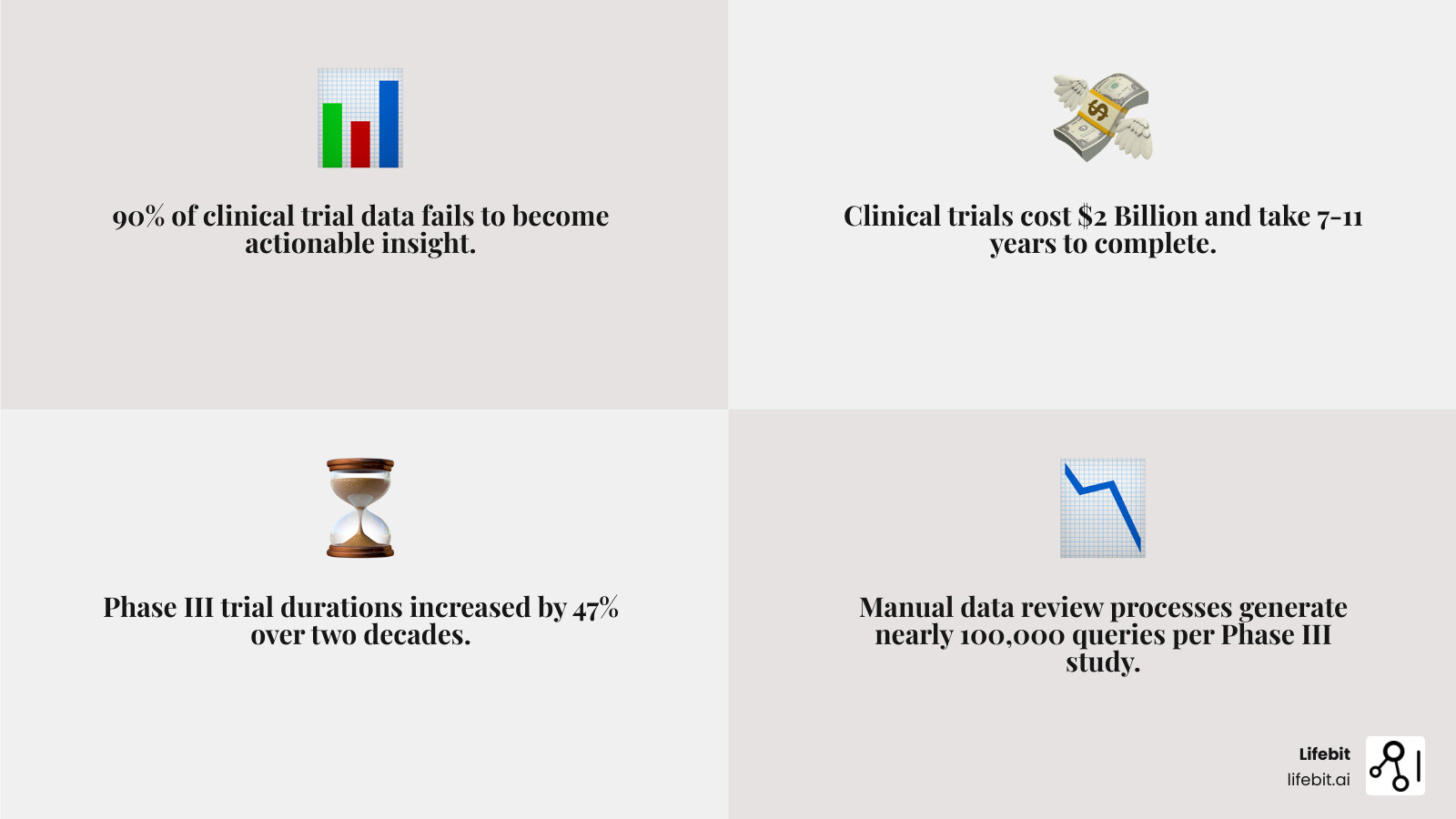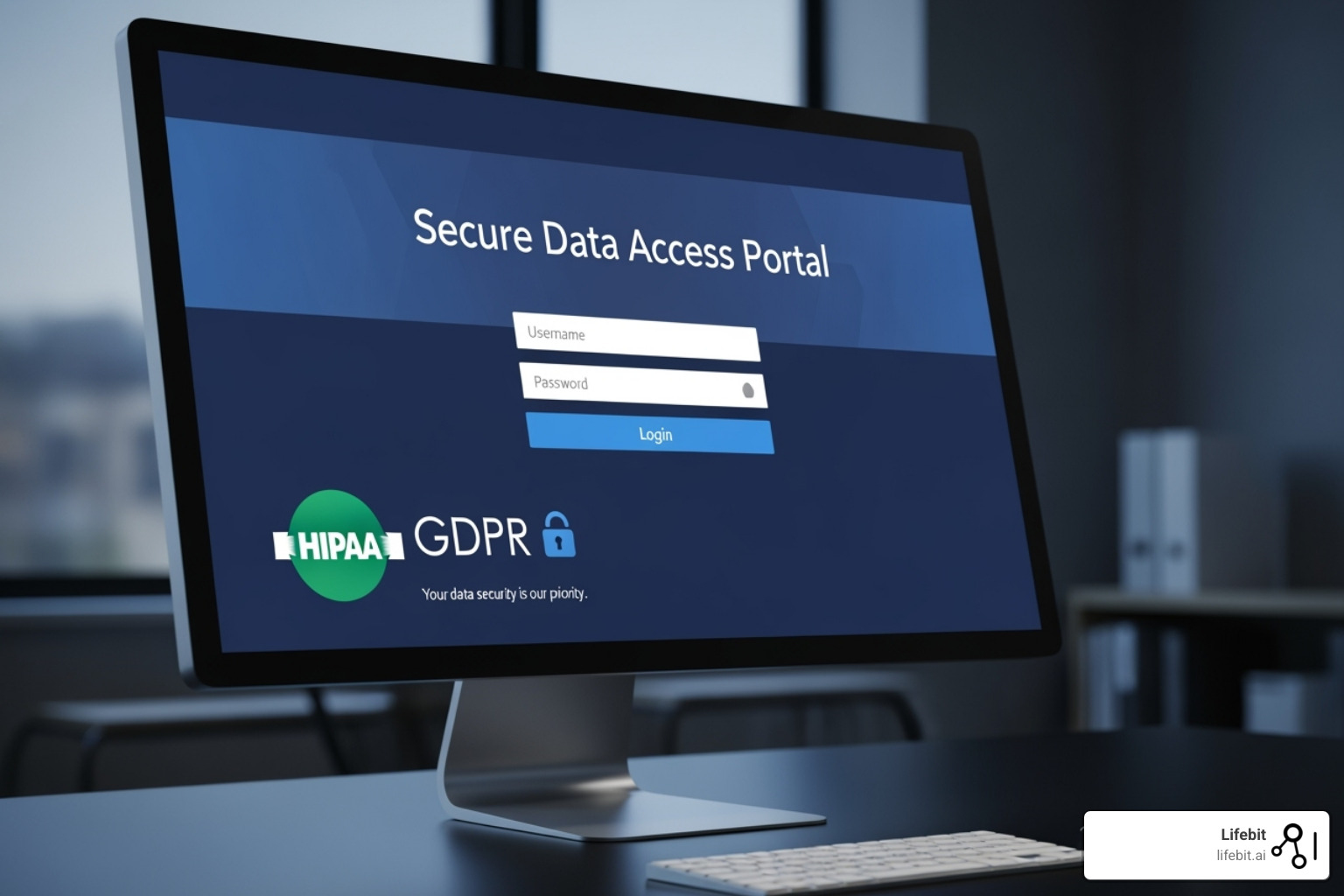Clinical Data Insights: The Key to Smarter Healthcare Decisions

Why Drug Development Costs $2 Billion (And How to Fix It)
Clinical data insights are the actionable intelligence from complex clinical trial and healthcare datasets that enable faster, safer, and more cost-effective drug development. Key components include:
- Data Integration – Combining EDC, imaging, lab results, wearables, and EHR data
- Advanced Analytics – AI/ML models that identify patterns and predict outcomes
- Visualization Tools – Dashboards that make complex data understandable
- Real-Time Monitoring – Continuous tracking of safety signals and trial performance
- Predictive Intelligence – Forecasting patient responses and trial success rates
The pharmaceutical industry faces a crisis: clinical trials cost an average of $2 billion and take 7-11 years, with only a 15% approval rate. R&D cycles now exceed 15 years, and Phase III trial durations have increased by 47% over the last two decades.
The culprit is data overload without insight.
Modern trials generate massive data volumes from sources like EDC systems, wearables, and EHRs. Yet 90% of this data fails to become actionable insight due to fragmentation, poor quality, and manual review processes that can generate nearly 100,000 queries per Phase III study.
However, organizations using advanced clinical data insights are seeing dramatic improvements: AI integration can reduce study timelines by up to 20%, predictive analytics can cut trial costs by 15-25%, and automated data review can shorten review cycles by up to 80%.
I’m Maria Chatzou Dunford, CEO and Co-founder of Lifebit, where I’ve spent over 15 years changing how organizations extract clinical data insights from complex biomedical datasets through federated AI platforms. My work spans computational biology, precision medicine, and secure data analysis across pharmaceutical and public sector institutions.

The Data Deluge: Why 90% of Clinical Trial Data Fails to Become Insight
Clinical researchers face a daily challenge: modern trials generate a tsunami of data from electronic data capture (EDC) systems, wearables, genomic sequencing, and electronic health records (EHRs). The volume and velocity are staggering, with terabytes of information flowing from dozens of sources for a single study.
The brutal reality is that 90% of this data never becomes actionable insight. It sits trapped in data silos, fragmented across incompatible systems, or buried under layers of poor quality and inconsistent formatting. This isn’t just an operational headache—it’s a $2 billion barrier between promising treatments and patients.
Stringent compliance requirements add complexity, and a critical shortage of skilled data managers exacerbates the problem. As highlighted in the challenge of a skilled labor shortage, the clinical data management sector is struggling to find qualified professionals to navigate this complex landscape. The good news is that organizations cracking the code on effective Clinical Data Integration Complete Guide are extracting meaningful clinical data insights.
Primary Challenges in Extracting Actionable Insights
The path from raw data to clinical data insights is littered with obstacles that prevent teams from realizing the full value of their data.
Data fragmentation is the biggest culprit. In a typical trial, a single patient’s data is scattered. Their demographic and visit data is in the EDC, lab results are in a LIMS from a central lab, imaging scans are in a PACS, and patient-reported outcomes are in a separate ePRO application. Without a unified view, it’s impossible to see the full picture of a patient’s journey, such as correlating a specific adverse event with a recent lab value and a dosing change.
Lack of standardization makes things worse. One clinical site might record blood pressure in mmHg, while another uses a different unit or custom terminology. Lab data may lack standardized LOINC codes for tests or SNOMED CT for diagnoses, making it nearly impossible to aggregate and compare data across sites and studies without a massive, manual harmonization effort.
Manual data review remains a slow, expensive, and error-prone nightmare. Teams spend countless hours writing validation scripts and manually reviewing listings to find discrepancies. When an issue is found, the inefficient data cleaning process begins: a data manager raises a query in the EDC, the site coordinator investigates the source document, the investigator reviews and responds, and the data manager closes the query. This cycle can take days or weeks for a single data point.
An Analysis of query volume in Phase III studies found that 20 Phase III studies generated approximately 1.9 million queries—nearly 100,000 per study. Each query represents a delay, a cost, and a drain on resources that could be used for higher-value analytical work.
The Human and Financial Cost of Inefficiency
These high query rates and manual processes have significant consequences. They divert precious resources from strategic analysis to low-level data cleaning, leading to burnout among highly skilled data managers. More importantly, these operational delays directly impact trial timelines. A one-day delay in a blockbuster drug’s launch can cost a sponsor millions in lost revenue. For patients, these delays mean waiting longer for life-changing treatments.
The Shift to Proactive Clinical Data Science
The industry is shifting from reactive data cleaning to proactive data science.
Instead of waiting for problems, forward-thinking organizations are adopting risk-based approaches to identify potential issues before they become roadblocks, focusing resources where they have the biggest impact. Centralized monitoring is becoming the new standard, giving teams a bird’s-eye view of data quality and trial performance across all sites and sources.
The real game-changer is leveraging AI and automation. Instead of being buried in spreadsheets, data managers are becoming strategic advisors focused on extracting meaningful clinical data insights. The SCDM position paper on the evolution to data science captures this change.
At Lifebit, our federated AI platform supports this evolution. We provide tools for advanced data harmonization, real-time monitoring, and compliant research that enable organizations to move beyond basic data management to true insight generation.
Spot Hidden Risks Faster with Data Visualization
After months of collecting clinical trial data, you’re left with endless spreadsheets. Analysis and visualization are what transform those raw numbers into meaningful insights.
Data visualization is your secret weapon for turning complex clinical datasets into clear, actionable stories. Instead of drowning stakeholders in numerical tables, you can create intuitive charts, graphs, and dashboards that speak to everyone, from statisticians to clinicians.
Effective visualization uncovers hidden patterns that might otherwise stay buried. When you visualize patient safety signals in real-time, you can spot potential adverse events hours or days faster than with traditional methods. This is about improving patient safety and accelerating decision-making when every day counts. Great visualization also serves as a universal language, bridging communication gaps. Storytelling with data makes complex findings accessible and compelling for all stakeholders.
Effective Data Visualization for Clinical Trial Data
Choosing the right visualization technique is key for generating clinical data insights.
- Scatter plots reveal relationships between two variables. For example, plotting drug dosage against a biomarker level can help identify the minimum effective dose and the point at which toxicity increases, defining the therapeutic window.
- Survival curves, often Kaplan-Meier plots, are crucial in oncology. They visually represent the probability of an event (like survival) over time, allowing for a clear comparison between a new therapy and a standard-of-care or placebo arm.
- Heat maps work wonders with large data matrices, such as gene expression data from RNA-seq. They use color gradients to instantly reveal clusters of genes that are up- or down-regulated in response to a treatment, helping to identify mechanisms of action or resistance.
- Box plots give a quick snapshot of data distribution, highlighting the median, quartiles, and outliers. They are invaluable for comparing lab values or adverse event severity scores across different treatment groups, quickly flagging potential safety concerns in one arm.
- Patient profiles are the gold standard for personalized monitoring. These comprehensive visual summaries aggregate all relevant data for an individual—demographics, dosing history, adverse events, concomitant medications, and key lab values—onto a single timeline. This allows monitors to track enrollment trends and spot safety signals at the patient level with unprecedented clarity.
Principles of Effective Clinical Data Storytelling
Creating impactful visualizations is an art and a science. Follow these principles to ensure your data tells a clear and compelling story:
- Know Your Audience: A dashboard for a clinical operations team monitoring enrollment should be different from one for a regulatory agency reviewing safety data. Tailor the complexity and focus to the audience’s needs.
- Choose the Right Chart: Don’t use a pie chart to show change over time. Use line charts for trends, bar charts for comparisons, and scatter plots for relationships. The right format makes the insight intuitive.
- Eliminate Clutter: Every element on your chart should serve a purpose. Remove unnecessary gridlines, borders, and distracting colors. This approach, often called a high “data-ink ratio,” helps the key message stand out.
- Use Color and Annotations Strategically: Use color to highlight key data points, such as a specific treatment arm or a cluster of outliers. Add text annotations to explain what the viewer is seeing, guiding them to the main conclusion.
Key Tools for Analysis and Visualization
Bringing these visualizations to life requires the right toolkit. Interactive dashboards have revolutionized data exploration, allowing users to filter, drill down, and customize views in real-time.
Statistical software like R (with packages like ggplot2) and SAS remain the workhorses for deep analytical dives, offering robust capabilities for advanced statistical analysis and customizable plots required for regulatory submissions. Python, with libraries like Matplotlib, Seaborn, and Plotly, has also become a powerhouse for creating both static and interactive visualizations.
Business Intelligence (BI) tools like Tableau and Power BI have democratized data visualization, allowing clinical teams without coding expertise to create their own reports and monitor high-level trends like site performance and patient recruitment.
The rise of self-service analytics is particularly exciting, empowering researchers to explore data independently. This agility is crucial in fast-moving clinical trials.
These tools, integrated with robust Clinical Research Technology infrastructure, are essential for turning raw data into meaningful clinical data insights. Our platform brings these capabilities together in a secure, compliant environment.
Cut Trial Costs by 25% and Timelines by 20% With AI
Imagine processing data from thousands of patients across multiple systems in hours, not months, and spotting patterns humans would miss. That’s the power of Artificial Intelligence (AI) in clinical research today.
If data is the new oil, AI and Machine Learning (ML) are the refineries that turn it into high-octane clinical data insights. This is a game-changer for how we approach clinical research.

The numbers speak for themselves: AI integration can slash study timelines by up to 20%, while predictive analytics can reduce trial costs by 15-25%. These are real results happening now.
Instead of waiting months for analysis, you get insights in real-time. Instead of missing safety signals buried in massive datasets, AI flags them immediately. Instead of guessing which patients might drop out, predictive models identify who is at risk.
Modern AI can process multi-modal datasets—genomics, imaging, EHRs, wearable data—all at once, finding connections analysts might miss. This comprehensive approach through Federated Learning in Healthcare is changing how we generate clinical data insights.
Integrating AI and Machine Learning with Visualization
When you combine AI’s pattern-finding power with smart visualization, complex algorithms become understandable dashboards.
- Patient subgroup identification becomes effortless. Unsupervised clustering algorithms (like k-means or hierarchical clustering) can analyze multi-omic and clinical data to automatically group patients with similar response profiles or risk factors. This can uncover hidden responder populations that were not predefined in the protocol, paving the way for personalized medicine and companion diagnostics.
- Natural Language Processing (NLP) unlocks insights from unstructured text. NLP models can parse millions of clinical notes, pathology reports, and patient comments to extract structured information like adverse events, disease progression, or medication adherence. This turns vast amounts of previously unusable text into quantifiable data for analysis.
- Predictive outcome modeling takes the guesswork out of trial planning. Using ML models like random forests or gradient boosting, sponsors can predict trial success rates, forecast enrollment timelines, and identify patients likely to drop out. This allows for proactive interventions, such as providing extra support to at-risk patients to improve retention.
- Anomaly detection acts as a vigilant watchdog. AI algorithms can constantly scan incoming data for quality issues, unexpected safety signals, or surprising treatment responses. For example, an algorithm can flag a lab value that is statistically improbable for a specific patient given their history, even if it’s within the normal range for the general population, indicating a potential safety signal or measurement error.
Recent advances in AI-ready datasets for trial prediction are making these applications even more powerful. Our platform brings these capabilities together in a secure, compliant environment.
Integrating Real-World Evidence (RWE)
Clinical trials are controlled environments; Real-World Evidence (RWE) shows what happens in real life. Combining trial data with RWE from claims databases, EHRs, and patient registries provides the full story.
This comprehensive patient view is invaluable, as RWE captures diverse populations often excluded from trials. Post-market surveillance becomes incredibly powerful when you can monitor long-term safety and effectiveness across entire populations. Validating trial findings with RWE gives you confidence in your results. When controlled trial data aligns with real-world outcomes, you know you’re on solid ground.
The trend is clear: over 85% of leading pharma companies now have RWE initiatives. They understand that integrating real-world data provides a more complete picture of patient outcomes, especially in complex areas like oncology.
Challenges and Solutions in RWE Integration
However, using RWE is not without its challenges. Real-world data is often messy, incomplete, and suffers from inherent biases (e.g., healthier patients may be more likely to have wearable data). To generate reliable insights, these issues must be addressed. Advanced statistical methods like propensity score matching can help create comparable cohorts between trial and real-world populations, reducing selection bias. Furthermore, federated platforms provide a solution to the governance and privacy hurdles of accessing sensitive RWE from different institutions, allowing analysis without data pooling.
Our platform enables secure integration and analysis of real-world data. For applications in oncology, explore our guide on Real-World Data for Clinical Evidence Generation in Oncology.
Avoid Costly Errors: The Foundation of Data Integrity and Security
Clinical data insights are only as reliable as their foundation. In clinical research, that foundation is built on three pillars: data integrity, security, and standardization.

Without these safeguards, even the most sophisticated AI algorithms are meaningless. Countries like Singapore are now conducting rigorous audits of clinical data quality, highlighting how critical this foundation is globally.
Compromised data integrity can invalidate years of research, security breaches can destroy patient trust, and a lack of standardization can make valuable data unusable. Getting these fundamentals right unlocks the true power of clinical research.
Building a Robust Data Governance Framework
Before any data is collected, a strong data governance plan is essential. This framework establishes clear rules for the entire data lifecycle. It defines data ownership and stewardship, sets quality standards and metrics, and outlines procedures for data access, usage, and security. A governance plan ensures that everyone involved—from site staff to data scientists—understands their responsibilities, creating a culture of quality and accountability from day one.
The Critical Role of Data Standardization (CDISC)
Clinical research without data standards is like a conversation where everyone speaks a different language. The Clinical Data Interchange Standards Consortium (CDISC) acts as the universal translator.
CDISC standards solve this problem. When data follows consistent formats, datasets from different studies, sites, and countries can communicate. The key standards include:
- SDTM (Study Data Tabulation Model): This standard dictates how to organize and format the data collected during a trial (e.g., demographics, adverse events, vital signs) into a standard structure. It is designed for regulatory submission, ensuring that agencies like the FDA and EMA receive data in a consistent, predictable format.
- ADaM (Analysis Data Model): This standard defines the structure for analysis-ready datasets. ADaM datasets are derived from SDTM data but are specifically designed to facilitate statistical analysis and reporting. This creates a clear, traceable path from data collection to analysis, which is critical for validating results.
The benefits are significant. Regulatory submissions become streamlined, as agencies can review standardized data more efficiently, which can slash review times. Meta-analyses and cross-study comparisons become possible, maximizing the value of every dataset.
Our Clinical Data Interoperability Complete Guide dives deeper into how these standards transform fragmented data. At Lifebit, we’ve built CDISC compliance into our platform’s DNA, ensuring every dataset is harmonized and ready for analysis.
Ethical and Secure Data Handling
Working with patient data is a profound ethical responsibility. Every data point represents a person who has trusted the research community with sensitive information.
Patient privacy protection starts with de-identification but also requires robust informed consent processes that ensure patients understand how their data will be used. The regulatory landscape is unforgiving, with HIPAA compliance in the US and GDPR in Europe setting strict rules for handling health information. Our HIPAA Analytics Best Practices guide helps organizations navigate these requirements.
Secure data access is paramount. This is where modern architectural patterns are game-changers:
- Trusted Research Environments (TREs): These are highly secure, access-controlled computing environments where de-identified data is made available to approved researchers for specific projects. The core principle is that the data never leaves the secure environment. Instead, researchers bring their analytical tools and code to the data. All results are vetted before being exported, preventing data leakage and ensuring compliance.
- Federated Learning: This approach takes data security a step further, enabling collaborative analysis without any data movement at all. An AI model is sent to multiple, decentralized data sources (e.g., different hospitals or research institutions). The model trains locally on each dataset, and only the aggregated, anonymized model updates—not the raw data—are sent back to a central server to create a global model. This technique is revolutionizing multi-institutional research by overcoming the barriers of data sharing.
Our federated AI platform enables these approaches for Data Security in Nonprofit Health Research and beyond.
Frequently Asked Questions about Clinical Data Insights
How does AI specifically help reduce clinical trial costs?
AI introduces smart, cost-cutting solutions to clinical trials.
Predictive analytics transforms site selection from guesswork into science. AI analyzes historical data to pinpoint which locations will deliver results, meaning fewer underperforming sites drain your budget.
Patient recruitment becomes laser-focused as AI identifies ideal patient profiles and predicts enrollment rates. Instead of casting a wide, expensive net, you target the patients most likely to enroll and complete the study. Leading consultancies estimate that predictive analytics alone can reduce trial costs by 15-25%.
Automated data review is a major game-changer. AI-powered tools can dramatically shorten data review cycles, with some platforms reducing review time by up to 80% per cycle. This saves significant time and money.
Perhaps most importantly, AI spots potential failures early. By catching safety concerns, efficacy issues, or enrollment problems sooner, you can make go/no-go decisions before investing further in a failing trial.
What is the difference between clinical trial data and Real-World Data (RWD)?
While both are essential, they serve different purposes.
| Feature | Clinical Trial Data | Real-World Data (RWD) |
|---|---|---|
| Data Source | Controlled clinical studies, EDC systems | EHRs, claims databases, registries, wearables |
| Collection Method | Standardized protocols, rigorous monitoring | Routine healthcare delivery, natural patient behavior |
| Patient Population | Carefully selected, homogeneous groups | Diverse, real-world patient populations |
| Data Structure | Highly structured, protocol-driven | Variable structure, often unstructured |
| Primary Use | Regulatory approval, efficacy demonstration | Post-market surveillance, real-world effectiveness |
Clinical trial data comes from highly controlled studies designed to prove efficacy and safety under ideal conditions.
Real-World Data (RWD) captures what happens when patients take medications in their normal lives. It includes everything from insurance claims to data from fitness trackers, showing how treatments perform outside the pristine walls of a trial.
The most powerful insights come from combining both data types. Clinical trial data proves a drug works under ideal conditions, while RWD shows how it performs in the real world. With over 85% of leading pharma companies now running RWE initiatives, this integrated approach is the new gold standard for clinical data insights.
How can organizations ensure the quality of data from diverse sources?
Ensuring data quality across diverse sources requires a robust framework to catch issues early.
- Start with a solid data governance plan that defines data ownership, collection standards, and quality metrics.
- Use CDISC standards to create a common language that allows different systems to communicate effectively. Without standards like SDTM and ADaM, integrating data is nearly impossible.
- Implement automated data validation checks to catch anomalies and inconsistencies in real-time, allowing for immediate correction.
- Leverage AI-powered anomaly detection to spot patterns that human reviewers might miss, from data entry errors to unusual patient responses.
- Create a centralized data framework to bring everything together. Our federated AI platform does exactly this, providing secure access to diverse data sources while maintaining the highest quality standards.
The key is to build quality measures into your process from the start, not as an afterthought. Prevention is always more cost-effective than a cure, especially for clinical data insights.

